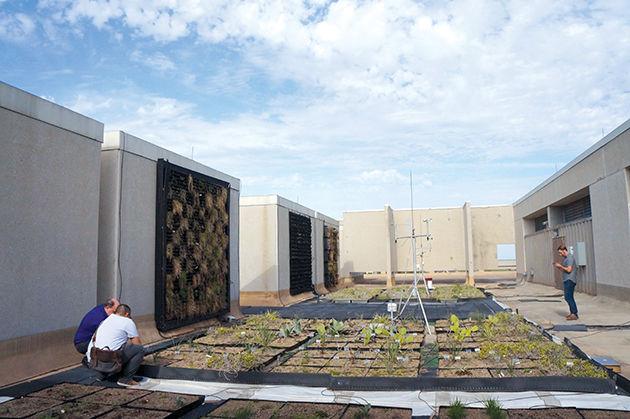Green roofs have thrived for hundreds of years in the Mediterranean climate but have not worked in areas like Texas. But an ongoing research project at the Langford Architecture Center has identified ideal plants and conditions for a green roof in the Texas climate.
Three A&M professors in architecture, atmospheric sciences and horticulture started this project to establish an understanding of green roofs — a garden atop a building — in Texas in 2012 and have successfully identified more than a more than a dozen plants that survive well in the southern climate.
Data is collected through hundreds of sensors that record ambient factors such as the soil moisture content, temperatures and the duration of sunlight. If they can determine the ideal conditions for Texas green roofs, they could have many benefits locally, including improved air quality and reduced energy consumption.
Bruce Dvorak, associate professor of landscape architecture, said the climate of Texas has been the hardest obstacle the team has faced.
“First year some of the plants died so we consolidated successful plants on one side and we started purchasing additional plants and we would start planting those and from the new plant teams we would have some successes and some failures so every year we just kind of keep modifying it,” Dvorak said.
Dvorak said the winter temperatures have played a major role in whether certain specie of plants survive and are best suited for Texas weather.
“We had 18 degrees [Fahrenheit] and that 18 degrees wiped out several plants that are marginally hardy here, so you kind of learn that you are in zone 8b here and even though you might have a mild winter three or four years in a row we’re going to have a cold temperature,” Dvorak said. “It doesn’t matter if it is one day or 15 days—still that one day can kill plants that are not cold hardy.”
Conlee said most meteorologists are environmentally minded but tend to lack the manual labor skills of designing green roofs to collect data, making this project attractive.
“In order to do science on a green roof it was clear to me that there would have to be a lot of sensing done, a lot of instrumentation,” Conlee said. “Meteorology these days can be kind of tied to the LED monitor and sitting in front of the computer. So I think even some of the manual labor skills of just assembling the green roof in the beginning was a real positive for the people that were involved and the chance to be next to plants.”
Despite the severe challenges posed by the extreme weather conditions, the project has identified more than 12 species that have done well on the roof. Zhihan Tao, landscape architecture graduate student and researcher, said the team will focus on urban agriculture on the roof in the coming months.
This research requires constant inventory and checking of equipment. Meteorology instructional professor Don Conlee said despite the weather climate, keeping the sensors working is an obstacle.
“One of our biggest challenges is keeping everything up and running,” Conlee said. “We’re looking at 27 soil moisture sensors, there’s 23 rooftop temperature sensors so there’s just a huge amount of things which is a lot more than a typical meteorological station … You don’t need 23 thermometers or 27 soil moisture probes and temperature probes.”
Conlee said one of the more interesting findings so far has been identifying the stark difference in rooftop temperatures between two bare and vegetated plots, which proves that it’s not the plot alone but the photosynthesis being carried out by the plants using the sun’s energy that ultimately prevents it from heating the roof.
Despite many of the advantages of a green roof, not all buildings may be structurally sound for a green roof, and many buildings would need to be retrofitted. However, Dvorak said the additional maintenance required for green roofs depends on the design of the green roof itself to a large extent.
“I would say that there’s not one roof on this campus that is not maintained already because you have to go up and do the annual inspections and those kinds of things. So yes, it would be another kind of maintenance but the benefits far outreach going with the cheapest possible solution,” Dvorak said.
The additional cost may be able to offset other expenses by reducing energy consumption in the building, by the capture and use of rainwater and through naturalized vegetation, which requires a lower level of maintenance.
“I would say just that people don’t have to be afraid of green roofs,” Dvorak said. “I think there’s a lot to be gained from studying and learning about these things and other universities are doing this all across the country so I think if we can push that direction more it would be a good thing.”
Langford’s roof goes green
March 6, 2017
Photo by Photo by Maria Fuentes
Associate professor Bruce Dvorak (purple) works with his graduate students to check temperature, status and growth of numerous plants.
0
Donate to The Battalion
$0
$2500
Contributed
Our Goal
Your donation will support the student journalists of Texas A&M University - College Station. Your contribution will allow us to purchase equipment and cover our annual website hosting costs, in addition to paying freelance staffers for their work, travel costs for coverage and more!
More to Discover








